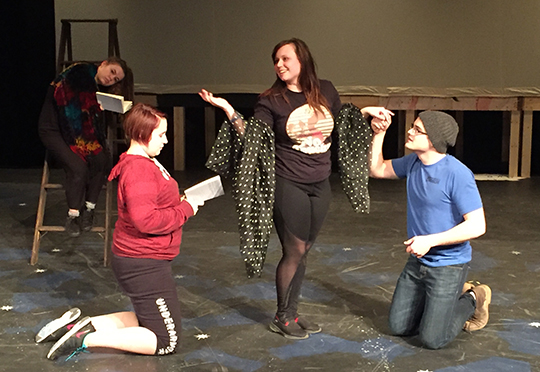“You have things like a witch burning onstage and a girl in a wooden dress who floats down a river,” said Terri Mastrobuono, director of “Rats’ Tales” and adjunct professor of theatre at Elizabethtown College. “There are things in this show that make you think, ‘Holy moly, how do you do this in live theatre’?”
Audience members will find out how the students executed these and more theatrical feats when the College closes its 2017-2018 theatre season with Carol Ann Duffy and Melly Still’s “Rats’ Tales.”
Using, as a frame, the well-known story of the Pied Piper of Hamelin taking a town’s children away, “Rats’ Tales” takes the audience on a journey with folktale-like stories of childhood and childhood lost. The show opens Thursday, April 19, in the Tempest Theatre.
Tyler Rossi, a junior theatre major, plays the Pied Piper. This character only appears at the beginning of the show, but Rossi’s “Rats’ Tales” acting doesn’t end there. Each actor in this production plays one main character and multiple supporting ones throughout the show. Personas such as the Pied Piper are referred to as “base characters.”
People will enjoy it because they’ll get to use their imaginations and watch other people do so.”
“For actors it’s really interesting because we’re playing a variety of different roles throughout the piece,” Rossi said, noting that many non-base characters maintain a trait of their base character to unite the stories. “I might have something of the Pied Piper’s physicality that I carry into a character, or I might carry his vocal cadence,” he said. “It’s so interesting to go from story to story and really try to make them their own people but also hint that they’re all in the same vein.”
“This show has a very particular acting style, which the cast is doing a great job with,” Mastrobuono said. “We’ve been doing a lot of inventing and playing and creating.”
The type of acting required for “Rats’ Tales” meshes well with Mastrobuono’s directing style, which she describes as “trial and error.” She often has actors repeat and experiment with scenes, encouraging everyone to offer ideas and input.
All stories are more than just their characters, and the “Rats’ Tales” stories are no exception.
Rats are seen as pretty shady creatures, and E-town’s production exemplifies this through its use of literal shadow. Throughout the show, actors (some playing humans, some playing rats) stand behind a large back-lit screen, and their shadows interact with the onstage characters.
Rossi plays his final character entirely in shadow. He said this adds extra difficulty because he must interact with onstage actors without being able to see them and move in ways that don’t distort his shadow.
“They’re contorting themselves back there,” Mastrobuono said.
Things learned in movement-themed rehearsal warm-ups come in handy whenever students mime different actions, which is often. The show uses minimal props, so the actors must create some themselves; one student mimes a pair of scissors by bending her arms and clapping them together while exclaiming, “snap!”
Because the play comprises brief, distinct tales, the students, onstage, are actors and storytellers at the same time, often breaking the fourth wall–speaking directly to the audience–as they narrate. Since the audience members are part of the show, Mastrobuono thought it was only fitting to have them seen at all times. The main stage lights will shine on some of the audience during the play to represent their active role as story listeners.
The production might be performed by college students, but, according to Mastrobuono, this is E-town’s first production, in a long time, to be advertised for all ages. She said audience members will relate to themes featured in the play, from family relationships to youth and love.
“People will enjoy it because they’ll get to use their imaginations and watch other people do so,” she said. “And different people will connect to it on different levels.”
But what about the rats? Rossi pointed out how humans see rats as both intelligent and disgusting. “In a way, this parallels the different sides of humans as a species,” Rossi said. “In the show we’re seeing what makes humans interesting, and what makes them a really ugly force.”
Subsequent performances are at 8 p.m. April 20, 21, 26 and 27 and at 2 p.m. Sunday, April 29.
“Expect to be entertained,” Rossi said. “I think [the audience] will leave with a lot on their minds, but in a good way.”
Stephanie Miller bio
Stephanie Miller is a junior English-Professional Writing major with a minor in communications. She also plans to complete a minor in psychology. On campus, she is the copy chief of the Etownian, serves as secretary of the Stitch2Serve knitting club and is a student writing tutor. After graduation, Miller hopes to pursue a career in journalism.


